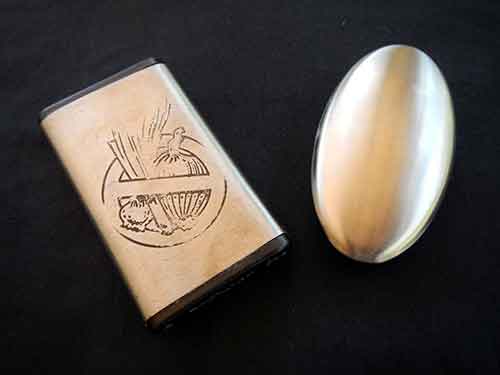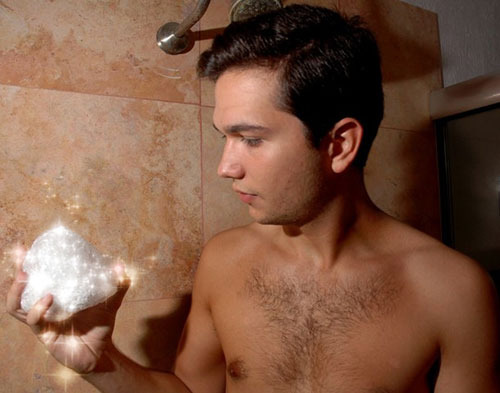By John Pint
 Many years ago, out of pure curiosity, I bought a soap-shaped bar made
of stainless steel, which, an ad claimed, would totally remove the
smells of garlic, onions or fish from your skin in seconds. All I had
to do was rub my fingers on the bar under a stream of cold water. To my
surprise, the steel bar performed perfectly and has continued to do so
for nearly 40 years. Even more surprising was my discovery that there
was absolutely nothing inside that hollow bar, no gimmick of any sort
that I could find.
Many years ago, out of pure curiosity, I bought a soap-shaped bar made
of stainless steel, which, an ad claimed, would totally remove the
smells of garlic, onions or fish from your skin in seconds. All I had
to do was rub my fingers on the bar under a stream of cold water. To my
surprise, the steel bar performed perfectly and has continued to do so
for nearly 40 years. Even more surprising was my discovery that there
was absolutely nothing inside that hollow bar, no gimmick of any sort
that I could find.
Fast forward to present time. We are in the workshop of master sculptor
Martín Navarro Ibarra of San Juan Evangelista, on the shore of Lake
Cajititlán in Jalisco, Mexico. Navarro Ibarra is describing some of his techniques and
allowing me to photograph them. I pick up one of his works of art:
“What a beautiful glaze on this pot,” I remark.
“It’s actually not a glaze at all,” says the sculptor. “Before I fire
the pot, I just burnish it with this…it completely transforms the
surface of the pot.” He picks up part of a car’s piston, a valve made
of shiny stainless steel.
“OK,” I say, “you just use something smooth…it could be a toothbrush
handle.”
His eyes open wide. “No, no! Nothing does the job like stainless steel.
I don’t know why, but I’ll show you how it works.”
He takes the valve and rubs it on the surface of an unfinished pot. A
miracle happens in front of my eyes. The rubbed area appears
beautifully glazed and the sculptor smiles.
I go home perplexed, straight to Google, of course. I find no end of
theories and speculations on why stainless steel is said to remove
various odors. References to the process of burnishing suggest that
contact with stainless steel may actually force molecules to rearrange
themselves and “lie down” in an orderly manner. I discover that
stainless steel “soap” for garlic and onions is more popular than ever
and is now touted as an efficient underarm and foot deodorant as well.
I begin to experiment with a large spoon. It looks pretty strange there
in the shower stall, but after a couple years I’m convince it works
quite well as a deodorant for all but extreme situations…and the
spoon’s long handle is great for sliding between your toes!
When I tell a friend this long, crazy story, he goes home and one week
later hands me a hollow piece of stainless steel, elegantly shaped like
a haute-couture bar of soap. “You can find anything downtown,” he
quips. “Here, I bought one for you too…and I agree: it does work.”
Disadvantages? It only works under a stream of running water, which
might not be readily available inside a tent, bedroom or airplane
washroom. Advantages: As long as you don’t lose the thing, I reckon it
will keep right on working for several hundred years. And as for the
cute soap-shaped bar: it floats!
And what is Weird Deodorant Number Two? See below!
WEIRD DEODORANT NUMBER TWO: ALUM, THE THAI CRYSTAL WITH 1000 USES
By John Pint
 Above, I sang the praises of “Stainless Steel Soap” as the world's cheapest deodorant. Above, I sang the praises of “Stainless Steel Soap” as the world's cheapest deodorant.
Now
let's look at another strange but wonderful deodorant, which I first
bumped into some 35 years ago in the form of a little crystalline rock
marketed as “Thai crystal deodorant.” You were supposed to wet it and
rub it in your armpits, but before I could properly evaluate its
merits, I dropped the rock on a hard floor and it shattered into a
thousand pieces.
Several decades later I found it again on
a pharmacy shelf in the USA, this time shaped and packaged in the style
of an ordinary push-up deodorant stick. I found this product to work so
well that I never bought another deodorant again, except for the
stainless steel kind, of course.
Just what is this crystal
composed of? Potassium aluminum sulphate, otherwise known as
alum, the third most abundant substance on earth after oxygen and
silicon. Why does it work as a deodorant? It is said to create a very,
very unfriendly environment for bacteria to grow in, and, of course,
the cause of body odor is bacteria. What are the advantages? It's said
to be “natural” and, despite its chemical name, contains no possibly
carcinogenic aluminum salts such as Aluminum Chlorohydrate, which
environmentalists frown upon and which blocks pores, preventing natural
sweating.
Disadvantages? You have to wet it before applying,
which could be a problem if you find yourself wandering in a desert
with no water. But then again, in that scenario smelling good may not
be your top priority.
Curiously, various references to this
mineral state that it has “long been known and used” not only in
Thailand, but in Mexico as well.
Long used in Mexico? Because I live in Mexico, I asked around and for while couldn't find a single soul who had ever heard of alumbre, which, I discovered, is Spanish for alum. Then I mentioned the word to my brother-in-law Pepe.
“Alumbre?”
he said. “Sí, cómo no. My father used to use it for whitewashing
fences...as a fixative.” Of course, when I suggested using a chunk of alumbre as a deodorant, he looked at me like I was crazy. This led me to Wikipedia
where I discovered alum was being used 'way back in Roman times, for
purifying drinking water, of all things. I also discovered that it's
good for pickling foods and tanning leather and is known as a fine
blood coagulant and flame retardant to boot. And it seems that alum was
used for hundreds of years as the secret ingredient of the Papal States
for fixing dye in wool.
Next I asked archaeologist Francisco
Sánchez about the use of alum in Mexico. He replied, “Fray Bernardino
de Sahagún (who has been called “the first anthropologist”) says the alumbre rock was well known in PreHispanic times and much used by tintoreros (dyers).” Now that I know this rock is good for just about everything and anything, I was not surprised when Sánchez told me alumbre
was also used by the Mixtecas to cure sicknesses. Deposits of alum, he
added, can be found in the municipio of Zacualtipan in the Mexican
state of Hidalgo.
If you live in Mexico and want a lump of alum
for yourself, you don't have to go all the way to Hidalgo. Just try the
most rustic-looking ferretería
(hardware store) you can find. If you prefer your rock dressed up like
a modern deodorant stick, you can order one from one of the providers
mentioned in the sidebar.
|

